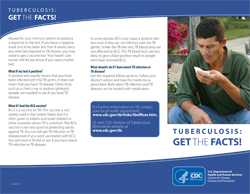Tuberculosis - Get the Facts!
What is tuberculosis?
Tuberculosis (TB) is a disease that usually affects the lungs. TB sometimes affects other parts of the body, such as the brain, the kidneys, or the spine. TB disease can cause death if it is not treated.
 How is TB spread?
How is TB spread?
TB germs are spread from person to person through the air. TB germs are put into the air when a person with TB disease of the lungs or throat coughs, sneezes, laughs, or sings. People nearby may breathe in the TB germs and become infected. TB is NOT spread by sharing silverware or cups, or sharing saliva when kissing someone.
What is the difference between latent TB infection and TB disease?
Latent TB infection
Not everyone infected with TB germs gets sick. People who are infected, but are not sick, have what is called latent TB infection. People with latent TB infection have TB germs in their body, but they are not sick because the germs lie dormant (sleeping) in their body.
People with latent TB infection do not have symptoms and cannot spread the germs to others. However, these people may develop TB disease in the future. To prevent developing TB disease, people with latent TB infection can take medicine.
TB disease
People with TB disease are sick from the large number of TB germs that are active in their body. They usually have one or more of the symptoms of TB disease. People with TB disease often feel weak or sick, lose weight, have fever, and have night sweats. If TB disease is in their lungs, they may also cough and have chest pain, and they might cough up blood. Other symptoms depend on what part of the body is affected by the TB germs.
People with TB disease may spread TB germs to others. TB disease needs to be treated with medicine. If NOT treated, a person with TB disease can have serious health problems and die.
Who is more likely to develop TB disease?
Once a person has TB infection, he or she has a higher chance of developing TB disease if the person
- Has HIV infection;
- Is younger than 5 years old;
- Was infected with TB germs within the last 2 years;
- Has other health problems, like diabetes, that make it hard for the body to fight germs;
- Abuses alcohol or drugs; or
- Was not treated correctly for TB disease in the past.
How can I tell if I have TB?
Get a TB skin test or TB blood test. If you have a positive result to either of the tests, you will be given other tests to see if you have latent TB infection or TB disease.
Where can I get a TB test?
You can get a TB skin test or blood test from your doctor or the local health department.
How are the TB tests given?
For a TB skin test, a health care worker uses a small needle to put some fluid, called tuberculin, just under your skin. This is usually done on the lower inside part of your arm. After you get the test, you must return in 2 to 3 days to see if there is a reaction to the test. If there is a reaction, the size of the reaction is measured to determine if you have a positive result.
If you receive the blood test, a sample of your blood will be taken to do the test. Your health care worker will tell you how to get the results of your test.
What if my TB test is negative?
A negative test usually means you are not infected with TB germs. However, the test may be falsely negative if your immune system is not working properly or if you were infected recently. This is because it usually takes 2 to 8 weeks after exposure to a person with TB disease for your immune system to produce a response to the test. If you have a negative result and it has been less than 8 weeks since you were last exposed to TB disease, you may need to get a second test. Your health care worker will let you know if you need another test.
What if my test is positive?
A positive test usually means that you have been infected with the TB germs. It does not mean that you have TB disease. Other tests, such as a chest x-ray or sputum (phlegm) sample, are needed to see if you have TB disease.
What if I had the BCG vaccine?
BCG is a vaccine for TB. This vaccine is not widely used in the United States, but it is often given to infants and small children in other countries where TB is common. The BCG vaccine is not very good at protecting adults against TB. You can still get TB infection or TB disease even if you were vaccinated with BCG. You will need a TB test to see if you have latent TB infection or TB disease.
In some people, BCG may cause a positive skin test even if they are not infected with the TB germs. Unlike the TB skin test, TB blood tests are not affected by BCG. The TB blood tests are less likely to give a false-positive result in people who have received BCG.
What should I do if I have latent TB infection or TB disease?
Get the required follow-up tests. Follow your doctor’s advice and take the medicine as prescribed. Both latent TB infection and TB disease can be treated with medication.
For further information on TB, contact your local health department.
Or visit: CDC Division of Tuberculosis Elimination website at www.cdc.gov/tb.
- Page last reviewed: August 1, 2012
- Page last updated: May 5, 2016
- Content source:


 ShareCompartir
ShareCompartir